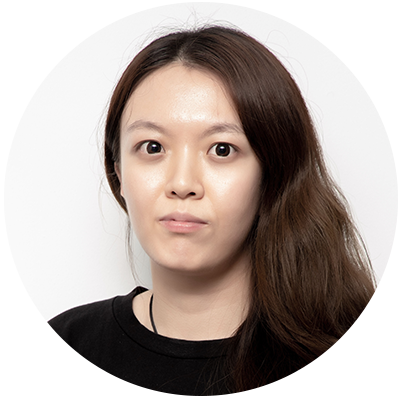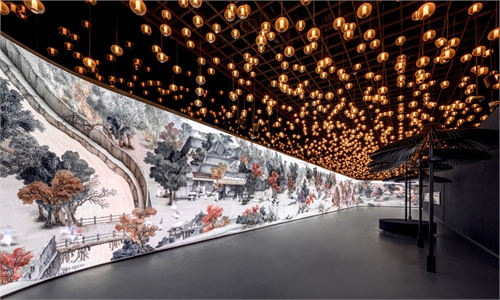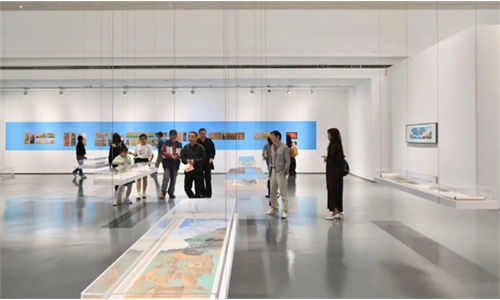ARTS / CULTURE & LEISURE
Nature, humanity, honoring emptiness come together in harmony in Chinese ink art
Reimagined in every stroke
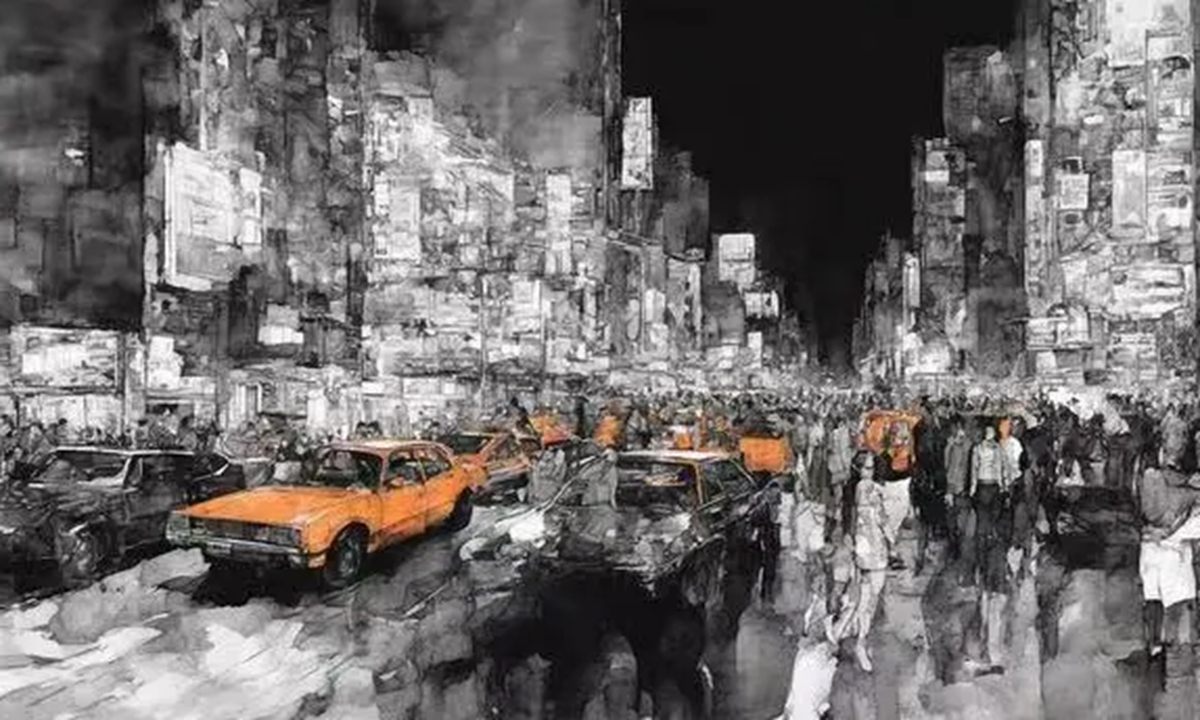
An artwork generated by AI trained on Hua Jun's ink painting database Photo: Courtesy of Hua Jun
Editor's Note:
The pursuit of beauty has been a timeless thread weaving throughout human history. China's distinct aesthetics are not only embodied in every aspect of Chinese life, but also increasingly bringing spiritual enjoyment to people of all cultural backgrounds in the form of artistic expression.
Vibrant neo-Chinese aesthetics are taking hold, blending China's rich heritage with contemporary creativity, offering a unique aesthetic experience, and enriching people's spiritual world. In this series about neo-Chinese aesthetics, the Global Times is presenting articles to decode the spiritual beauty reflected in various art forms.
This article will prepare for you a brush, paper, and ink, inviting you to journey through flowing poetry alongside masters of Chinese ink painting, enthusiasts who traveled to China in pursuit of its artistic essence, and avant-garde artists inspired by ink's timeless aesthetics.
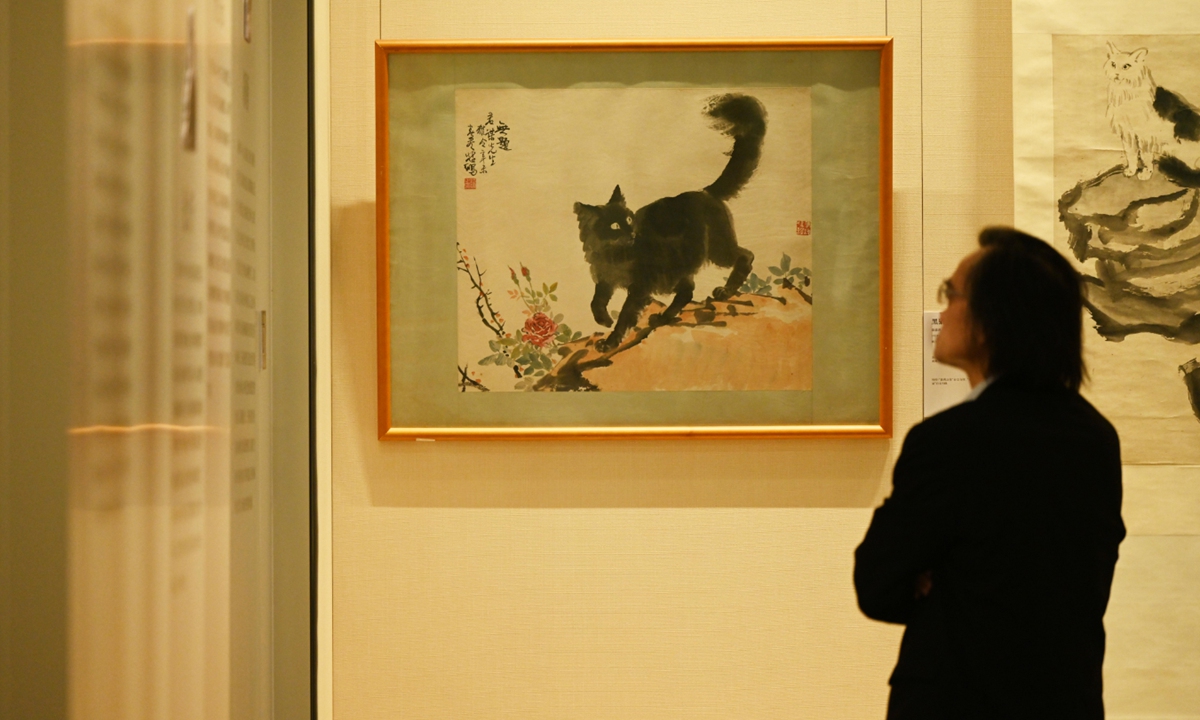
A visitor admires a painting by Xu Beihong. Photo: VCG
If you were tasked with painting a snow scene using nothing but a brush dipped in black ink, how would you begin?
Zhao Ji, an emperor of the Northern Song Dynasty (960-1127), approached this by outlining the contours of mountains and trees with delicate ink lines, then using liubai, or the untouched white of the paper, to evoke the snow blanketing their forms. He even added figures sweeping the snow and a slow-moving procession, capturing not only the serene beauty of the snowy riverside but also the poetic rhythm of life beyond the paper.
Let's say you wished to capture the charm of a cat with ink on rice paper, how would you approach this new task?
Xu Beihong, a pioneer of 20th-century Chinese painting, painted a cat perched on a rock, its gaze wandering in every direction. With varying shades of black ink, he brought each part of the cat's body to life - some bold and dark, others soft and light - imbuing it with a vivid sense of tension, as if, in the very next moment, the cat might leap into action.
At first glance, Zhao appears to be painting snow, and Xu a cat, yet what they truly seek to convey is a boundless spirit and feeling that extends far beyond the canvas. When Hua Jun, a modern Chinese painter and professor of the China Academy of Art, lays ink to paper to depict the mountains in his heart, he weaves this ink aesthetic into every brushstroke, striving to reach the realm where "a mountain is no longer just a mountain."
Hua told the Global Times that the beauty of ink lies in its spirit. No matter how contemporary artists innovate in ink, this spirit of ink, rooted in the harmony between nature and humanity, has long transcended the two-dimensional plane, becoming a source of nourishment for the growth of various new Chinese-style art forms, such as architecture, fashion, and the performing arts.
The soul of ink
With a graceful sweep of his hand, Hua added another stroke to the canvas.
This wasn't in a studio, but in a gallery. On the eve of his solo exhibition held in Shanghai, his works had already been mounted on the walls, the curation meticulously completed. Yet the painter wandered through the exhibition hall, brush in hand, as though strolling amidst the very mountains and stones he brought to life through his own strokes.
Hua began studying traditional Chinese painting from a young age, delving deeply into landscapes, flowers, and birds. Now, he has turned his focus to painting mountains. His ink paintings, composed solely of mountains and rocks, are vast in scale, and without foregrounds or backgrounds, they appear even more grand and imposing. At the exhibition, one viewer once asked him why he no longer painted people. Hua replied, painting mountains is also painting people.
"In ink painting, whether it is landscapes, flowers and birds, or figures, they are all merely vessels. What matters most is using these vessels to convey ideas and spirit. This is what we mean when we say that art originates from life but must also transcend it," said Hua, pointing out expression of emotions through scenery and objects is, in his view, the soul of Chinese ink art.
Ink art interprets aesthetic concepts such as "the unity of humanity and nature," imbuing the natural scenery before one's eyes with overlooked poetic qualities, Ren Junwei, an associate professor from the Academy of Fine Arts at Capital Normal University, told the Global Times.
The soul of ink not only resonates deeply with generations of Chinese artists but also inspires creators from around the world. Giacomo Bruni, a 30-something Italian painter, is one of them.
In 2012, a cultural exchange program brought Bruni to Guangzhou. There he met the painter Guan Shanyue, as well as Chinese ink painting. One master's work in particular caught him off guard: "I saw that you weren't looking at nature, as in Western art. You can be inside it."
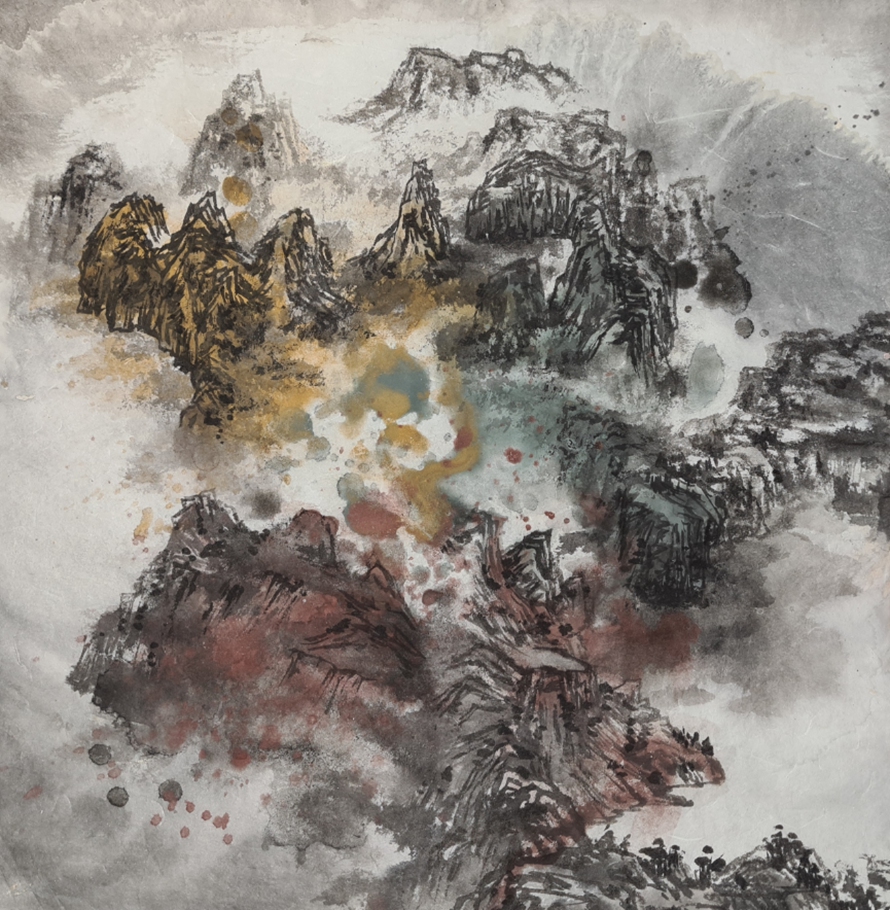
A painting by Giacomo Bruni Photo: Courtesy of Giacomo Bruni
Ink painting embodies a Taoist dialogue between the observer and the cosmos, portraying nature as something we are a part of, rather than something we stand apart from."The Italian sees in ink painting a counterpoint to the alienation of capitalist modernity, where both nature and art are reduced to commodities. The values embedded in the tradition - harmony, humility, the honoring of emptiness - in his view offer an ecological and spiritual critique as relevant now as it was a thousand years ago.
A decade later, Bruni settled in China and since then has been exploring the spirit of ink during his creation. One recent work, exhibited at his Fangsai Art Museum, spans both wall and floor, inviting visitors to step into it.
"You can interact with the painting," Bruni explained. "The idea came from the concept of woyou, wandering within the landscape, which comes from Zong Bing's writings in the Southern Song Dynasty (1127-1279). I wanted to create a painting that helps people actually go inside the scene."
An experiment
Bruni has been experimenting with ink and the Chinese philosophy it embodies, exploring how far traditional ink art can evolve within a contemporary and international context.
At the China Academy of Art where Bruni recently completed a degree in Chinese painting, Hua set up a course on experimental ink art, discussing about how to transform the ancient language of ink painting into contemporary language, and how ink art can coexist and integrate with other art forms in modern time.
This course guides students to expand their painting techniques through experimentation. For example, in traditional ink painting, only water is added to the ink. However, if the water contains other substances, such as hand soap, it can create entirely new possibilities for the ink's tones and effects, Hua introduced.
In the ink experiments of artists like Hua and Bruni, the canvas has never been the sole medium for creation. Hua applies the aesthetics of ink painting to various art forms, such as installation art and video art. In one of his works, he wrote on a wall using glue and then sprinkled ashes onto the still-wet glue, deconstructing the traditional meaning of ink.
Daisy, a young Chinese filmmaker currently based in Europe, is exploring ways to move beyond the static form of traditional ink art by incorporating cinematic languages that bring ink paintings to life. She together with Yalun Li and Feiyue Chen from the Dunes Workshop imprinted various key locations along the Beijing Central Axis with data collected from 3D scanning. Soft and nebulous, point cloud imagery was animated and montaged into a three-minute video with a city soundscape that reads as a flowing contemporary ink painting.
This video installation is currently on view at Venice Architecture Biennale until November 2025.
"Ink painting for me is more of a philosophy than a form. It essentially is about the fusion of water and ink - a dance of relationship, which underpins the essence of all creative work, be it painting, film, or sculpture." Daisy told the Global Times, "To express this relationship, it is key to understand liubai, or blank space, as in how to let the void speak for itself."
A prospect
In various forms of new Chinese-style art, the philosophy rooted in ink painting is deeply integrated, influencing design concepts in architecture, fashion, stage design, and more. The aesthetic of neo-Chinese ink has not strayed from the fundamentals of traditional ink art, its emphasis is on brushwork, mood and atmosphere and its goal is to discover and reveal the quiet beauty and spiritual aesthetic that often goes unnoticed, Ren explained.
In Bruni's view, neo-Chinese ink, deeply rooted in tradition, serves as a medium to cultivate genuine intercultural understanding. He aspires to one day establish an art academy in Europe, where students can study Chinese ink painting.
"Not as something exotic or foreign, but as a living tradition that can enrich their perspective on the world," said the painter.
Hua has embarked on a new journey of exploration based on this living tradition. Using his own works as material, he inputs prompts to create a dialogue between ink art and AI technology, resulting in a "new ink art" that combines his personal style with technological elements.
Is this the future of ink art? The answer remains uncertain, but this artist has chosen to embrace technology while also reflecting on the relationship between technology and ink.
